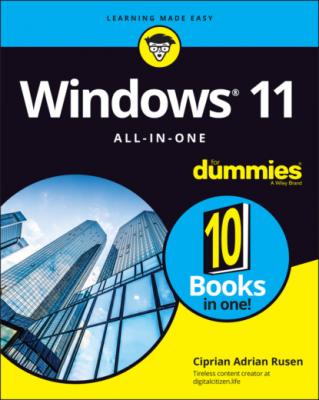Windows 11 All-in-One For Dummies. Ciprian Adrian Rusen
Чтение книги онлайн.
Читать онлайн книгу Windows 11 All-in-One For Dummies - Ciprian Adrian Rusen страница 21
 macOS on it: Check out
macOS on it: Check out www.hackintosh.com. But, no, it isn’t legal — the macOS End User License Agreement explicitly forbids installation on a non-Apple-branded computer. Also, installing it is certainly not for the faint of heart.The performance of the latest MacBook Air and MacBook Pro, based on Apple’s M1 chips, is breathtaking. However, they can natively run only macOS, not Windows. If you want Windows on the latest MacBooks, you must purchase Parallels Desktop 17 for Mac or newer, from www.parallels.com.
Linux: The big up-and-coming operating system, which has been up-and-coming for a couple of decades now, is Linux (pronounced “LIN-uchs”). If you are not an IT professional and you plan to use your PC only to get on the internet — to surf the web and send emails — Linux can handle that, with few of the headaches that remain as the hallmark of Windows. By using free programs such as LibreOffice (www.libreoffice.org) and online services such as Google Workspace and Google Drive (www.drive.google.com), you can even cover the basics in word processing, spreadsheets, presentations, contact managers, calendars, and more. Even though Linux doesn’t support the vast array of consumer hardware that Windows offers, it’s popular with many software developers and power users.
In the tablet sphere, iPadOS and Android rule. Windows 11 doesn’t compete with any of them, even though it works on Qualcomm chips designed for mobile devices, and is available on tablets and convertible devices such as the Surface line.
What do other people choose? It’s hard to measure the percentage of PCs running Windows versus Mac versus Linux. StatCounter (www.statcounter.com) specializes in analyzing the traffic of millions of sites globally and provides lots of useful statistics based on the data they collect. One stat tallies how many Windows computers hit those sites, compared to macOS and Linux. While their data may not be 100 percent representative of real-world market share, it does an excellent job of giving us an idea of operating system penetration. If you look at only desktop operating systems — Windows (on desktops, laptops, 2-in-1s) and macOS/OS X — the numbers in July 2021 (according to StatCounter) broke as shown in Figure 1-3. (Linux and Chrome OS barely have more than 1 percent market share, each).
FIGURE 1-3: Worldwide market share of desktop operating systems from July 2020 to July 2021.
In July 2021, Windows had a market share of 73 percent of all desktop operating systems, and macOS had 15 percent. In Microsoft’s world, Windows 10 is king with a 78 percent market share. Windows 7 is a distant second, with 16 percent, a value that is constantly declining because Microsoft declared its end of life on January 14, 2020. Users are no longer receiving support and updates for Windows 7, and they are highly encouraged to upgrade to Windows 10 or Windows 11. The graph doesn't include a market share for Windows 11 because it hadn't been launched. I expect it to reach levels similar to Windows 10 in just a couple of years.
Understanding Important Terminology
Some terms pop up so frequently that you’ll find it worthwhile to memorize them or at least understand where they come from. That way, you won’t be caught flat-footed when your first-grader comes home and asks to install TikTok on your computer.
Windows 11, the operating system (see the preceding section), is a sophisticated computer program. So are computer games, Microsoft Office, Microsoft Word (the word processor part of Office), Google Chrome (the web browser made by Google), those nasty viruses you’ve heard about, that screen saver with the oh-too-perfect fish bubbling and bumbling about, and more.
An app or a program or a desktop app is software (see the earlier “Hardware and Software” section in this chapter) that works on a computer. App is modern and cool; program is old and boring, desktop app or application manages to hit both gongs, but they all mean the same thing.
A Windows app is a program that, at least in theory, runs on any edition of Windows 11. By design, apps (which used to be called Universal Windows Platform, or UWP apps) should run on Windows 11 and Windows 10 on a desktop, a laptop, and a tablet— and even on an Xbox game console, a giant wall-mounted Surface Hub, a HoloLens augmented reality headset, and possibly Internet of Things tiny computers. They also run on Windows 11 in S mode (see the preceding section). Here's a neat trick that’s available only in Windows 11: It can install and run Android apps too, but only through the Microsoft Store. I talk more about this topic in Book 5, Chapter 1.